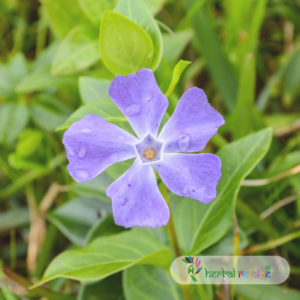Introduction
Vinca major (Linn.) Pich., commonly known as Green Periwinkle or Greater Periwinkle, is a medicinal herb known for its astringent and antihaemorrhagic properties. This article explores the many therapeutic applications of Vinca major and its chemical composition, making it a valuable addition to traditional medicine practices.
Native to Europe, Vinca major can also be found in the Himalayas, West Bengal, and Palni Hills. Its English names, Green Periwinkle and Greater Periwinkle, reflect its attractive green foliage and vibrant flowers. However, it is not to be confused with Vinca rosea L., which is known for its cancer-fighting properties.
Medicinal Uses
In traditional medicine, Vinca major is primarily used to treat menorrhagia (excessive menstrual bleeding) and leucorrhoea (abnormal vaginal discharge). Both conditions can cause discomfort and distress for those affected. The herb’s astringent and antihaemorrhagic properties work together to help reduce excessive bleeding and alleviate symptoms.

Chemical Constituents
The therapeutic benefits of Vinca major can be attributed to its rich chemical composition. This herb contains various indole alkaloids, including majdine, isomajdine, majoridine, akuammine, akuammigine, carpanaubine, irvine, reserpine, serpentine, sarpagine, tetrahydroalstonine, vincamajine, and vincamajoreine. These alkaloids contribute to the herb’s medicinal properties and are responsible for its astringent, antihaemorrhagic, and hypotensive actions.
In addition to alkaloids, Vinca major also contains tannins. Tannins are polyphenolic compounds known for their antioxidant and antimicrobial properties. These compounds further enhance the herb’s therapeutic potential, aiding in the treatment of menorrhagia and leucorrhoea.
It is important to note that although Vinca rosea L. is commonly used in the treatment of certain types of cancer, the cytotoxic dimeric alkaloids present in this plant have not been found in Vinca major. Therefore, Vinca major should not be relied upon as a cancer-fighting remedy.
Conclusion
In conclusion, Vinca major (Green Periwinkle) offers a natural and holistic approach to the treatment of menorrhagia and leucorrhoea. With its astringent, antihaemorrhagic, and hypotensive actions, this herb can help alleviate symptoms and provide relief. Its chemical composition, including indole alkaloids and tannins, contribute to its medicinal properties. However, it is important to consult with a healthcare professional before incorporating Vinca major into any treatment plan.
Frequently Asked Questions
What is Vinca major?
Vinca major, commonly known as Green Periwinkle or Greater Periwinkle, is a medicinal herb known for its astringent and antihaemorrhagic properties.
Where is Vinca major found?
Native to Europe, Vinca major is also found in the Himalayas, West Bengal, and Palni Hills.
What are the medicinal uses of Vinca major?
Vinca major is primarily used to treat menorrhagia (excessive menstrual bleeding) and leucorrhoea (abnormal vaginal discharge), alleviating discomfort and distress associated with these conditions.
What chemical constituents are found in Vinca major?
The herb contains various indole alkaloids, including majdine, isomajdine, majoridine, akuammine, and others. It also contains tannins, which have antioxidant and antimicrobial properties.
How do the properties of Vinca major help in treating conditions?
The astringent and antihaemorrhagic properties of Vinca major work together to reduce excessive bleeding and alleviate symptoms associated with menorrhagia and leucorrhoea.
Is Vinca major the same as Vinca rosea?
No, Vinca major should not be confused with Vinca rosea, which is known for its cancer-fighting properties. The cytotoxic dimeric alkaloids present in Vinca rosea have not been found in Vinca major.
Can Vinca major be used safely?
While Vinca major offers various medicinal benefits, it is essential to consult a healthcare professional before using it to ensure safe and effective use.
What forms of Vinca major are available?
Vinca major is commonly available in dried leaf or flower forms, as well as in herbal supplements or extracts.
Are there any known side effects of Vinca major?
There are limited documented side effects, but potential issues may arise from overuse. Consultation with a healthcare professional is recommended for guidance.
How should Vinca major be prepared for use?
Preparation methods may vary but typically include making infusions, decoctions, or topical applications of the leaves and flowers.
Can Vinca major be combined with other herbs?
Yes, it can be combined with other herbs in traditional formulations; however, it is advisable to seek professional guidance before combining herbal remedies.
What precautions should be taken when using Vinca major?
It is important to ensure proper identification and sourcing of the herb. Consulting a healthcare professional before use is essential for safe and effective treatment.
How can I source Vinca major?
Vinca major can be sourced from herbal shops, traditional medicine practitioners, or online retailers specializing in herbal products.
What are the storage recommendations for Vinca major?
Store dried Vinca major in a cool, dark, and dry place to maintain its potency and extend its shelf life.
Is Vinca major used in any specific traditional practices?
Yes, Vinca major is often utilized in traditional medicine, particularly for addressing women’s health issues like menorrhagia and leucorrhoea.
Can I grow Vinca major in my garden?
Yes, Vinca major can be grown in gardens, provided that it is given suitable conditions that mimic its natural habitat.


